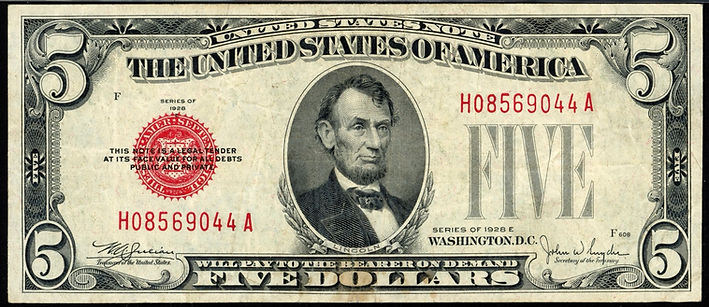Census Data on U.S. Small-Size Varieties & More
1928C-1928E $5 Legal Tender
Late-Finished BP #637 Mules
Backplate 637 entered routine service producing sheets on June 23, 1945, and supplied a steady stream of sheets until June 2, 1949. During that time those sheets were mated with a host of $5 silver certificates, legal tender, and federal reserve note faces to create a plethora of rare varieties. They have long been recognized and revered by collectors owing to the distinctive micro-size 637 plate serial number that contrasted with contemporary notes having macro-size four-digit plate serial numbers.

$5 Backplate #637 Proof
Image courtesy of Jamie Yakes
Five-dollar back plate 637 spent most of its life as a master plate that directly and indirectly fathered all small-size twelve-subject $5 back plates made between 1935 and 1951. It was the most important plate of its era. The design it carried was rendered obsolete in 1951 when back plates with new designs began to be made. Originally, back 637 had been used to impart a previous design change to $5 backs.
By 1928, sheet spoilage had become a serious problem for plate printers because of tight margins on finished sheets created by the narrow vertical separations between each subject on printing plates. The BEP resolved this in 1934 by increasing the vertical separations between subjects, on what were called new-gauge plates. This change required the production of new master plates and commenced with the production of a new-gauge $1 steel master face in July.
The change for $5 backs came on October 26, 1935, when the BEP started $5 new-gauge steel master back plate 630. Each subject impressed on 630 was spaced slightly farther apart in the vertical direction to create wider margins on the printed sheets. Back plate 637 was begun a few months later on January 24, 1935. It was immediately pressed into service as the new $5 master plate and would remain so for the next eight years. At this time serial number 637 was not etched into any subjects on the plate.
Backplate 637 was retired as a master plate in 1943 and saved as an economic measure. The following year it was salvaged and certified as a production plate on November 10, 1944. Plate serial number 637 was etched into each subject in micro-size numerals similar to those used on plates finished prior to January 1938. The plate met its demise five years later when it was canceled on June 14, 1949, fourteen years after it was made.

Micro-size Mule
Late-Finished BP #637
No other plate in the history of U.S. currency had a more varied life. Back 637’s legacy is vast: It fathered more than fifteen hundred $5 back plates between 1935 and 1951, and as a production plate produced some of the most desirable small-size mules. Back 637 sheets were mated with faces from $5 Legal Tender Series of 1928C, 1928D, and 1928E and across three blocks (G-A, H-A, & *-A). It was also mated with faces from the $5 Silver Certificate Series of 1934A, 1934B, and 1934C across six different blocks and Federal Reserve Note (FRN) Series of 1934, 1934A, 1934B, and 1934C across ten different districts, depending on the series.
Written by Jamie Yakes


1928C $5 LT G-A Block Mule - Macro FP #520, Micro LFBP #637


1928C $5 LT LFBP #637 Mule Star - Macro FP #486, Micro LFBP #637 - currently unique
Images Courtesy of Heritage Auctions


1928D $5 LT G-A Block Mule - Macro FP #538, Micro LFBP #637


1928E $5 LT G-A Block Mule - Macro FP #579, Micro LFBP #637
***Currently the lowest serial number known for 1928E Mules***


1928E $5 LT H-A Block Mule - Macro FP #608, Micro LFBP #637


1928E $5 LT Mule Star - Macro FP #576, Micro LFBP #637
Images Courtesy of Heritage Auctions
Related SPMC "Paper Money" Journal Articles
"Collecting the Impossible!"
July/Aug 2020 - Whole #328; pgs 454-456; Robert Calderman (Cherry Picker's Corner)
"Extraordinary First Ten Years of Micro Back 637"
May/June 2016 - Whole #303; pgs 212-215; Jamie Yakes
"The Enduring Allure of $5 Micro Back Plates 629 & 637"
Sept/Oct 2015 - Whole #299; pgs 304-326; Peter Huntoon
The Census Report
Updated 01/01/2025
9 New Notes
Notes Included:
1928C LFBP #637 Mules
1928D Mules (LFBP #637)
1928E Mules (LFBP #637)
Notes Not Included:
Current Census Population

